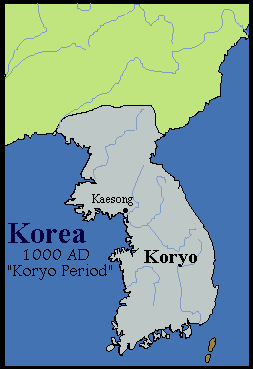

|
|
 Koryo Period Koryo PeriodExternal problems and internal dissensions between the king and regional leaders led to the destruction of Shilla as a political entity around 935 AD. Remnants of the old three kingdoms reappeared briefly until unified again, this time by the northern state of Koryo. (The name derives from "Koguryo" and is the root of the modern name "Korea.") The Koryo era (935-1392 AD) was marked by periodic internal dissensions and external (mostly defensive) wars with China, Manchuria, and Japan. But there were also many achievements. In the century of peace following a peace treaty with the Liao of China in 1022 AD, there was a flowering of culture that led to great advances in scholarship and art, particularly in the ceramics industry, which developed the distinctive grey-green celadon stoneware for which Korea is well-known today. Unfortunately, strains between the aristocracy, military, and kings created instability in the 1200s. Invasions by the Mongols after 1231 AD nearly destroyed Koryo, but in the struggle to remove the Mongols, the kings became dominant again, leading eventually to a resurgence of the central government. During this time, Europe was still in the Medieval period. The Crusades were fought, and the nuclei of modern states like England, France, and Germany formed.
[ Korea Yesterday ] [ Old Choson Period ] [ The Three Kingdoms ] [ Home ] [ Teacher Pages ] [ Modules & Activities ] |
HTML code by Chris Kreger
Maintained by ETE Team
Last updated April 28, 2005
Some images © 2004 www.clipart.com
Privacy Statement and Copyright © 1997-2004 by Wheeling Jesuit University/NASA-supported Classroom of the Future. All rights reserved.
Center for Educational Technologies, Circuit Board/Apple graphic logo, and COTF Classroom of the Future logo are registered trademarks of Wheeling Jesuit University.